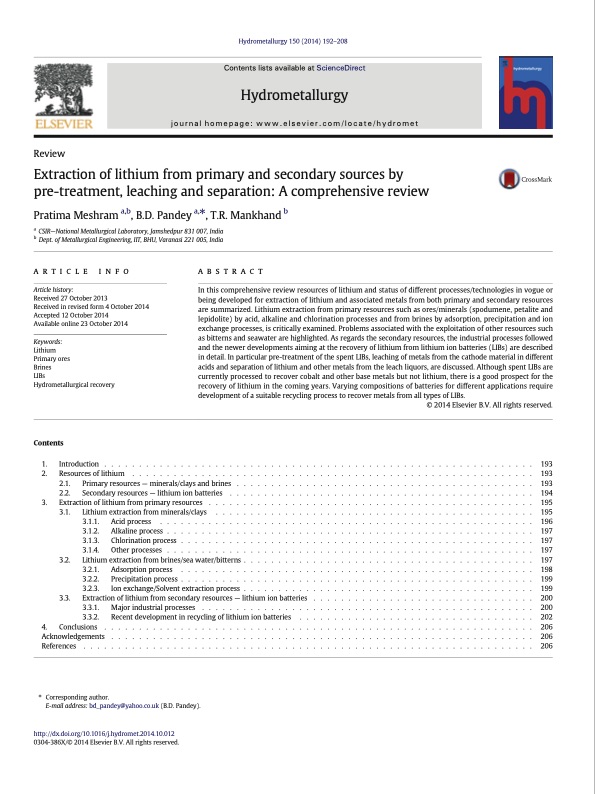
PDF Publication Title:
Text from PDF Page: 001
Hydrometallurgy 150 (2014) 192–208 Contents lists available at ScienceDirect Hydrometallurgy journal homepage: www.elsevier.com/locate/hydromet Review Extraction of lithium from primary and secondary sources by pre-treatment, leaching and separation: A comprehensive review Pratima Meshram a,b, B.D. Pandey a,⁎, T.R. Mankhand b a CSIR—NationalMetallurgicalLaboratory,Jamshedpur831007,India b Dept.ofMetallurgicalEngineering,IIT,BHU,Varanasi221005,India article info Article history: Received 27 October 2013 Received in revised form 4 October 2014 Accepted 12 October 2014 Available online 23 October 2014 Keywords: Lithium Primary ores Brines LIBs Hydrometallurgical recovery Contents abstract In this comprehensive review resources of lithium and status of different processes/technologies in vogue or being developed for extraction of lithium and associated metals from both primary and secondary resources are summarized. Lithium extraction from primary resources such as ores/minerals (spodumene, petalite and lepidolite) by acid, alkaline and chlorination processes and from brines by adsorption, precipitation and ion exchange processes, is critically examined. Problems associated with the exploitation of other resources such as bitterns and seawater are highlighted. As regards the secondary resources, the industrial processes followed and the newer developments aiming at the recovery of lithium from lithium ion batteries (LIBs) are described in detail. In particular pre-treatment of the spent LIBs, leaching of metals from the cathode material in different acids and separation of lithium and other metals from the leach liquors, are discussed. Although spent LIBs are currently processed to recover cobalt and other base metals but not lithium, there is a good prospect for the recovery of lithium in the coming years. Varying compositions of batteries for different applications require development of a suitable recycling process to recover metals from all types of LIBs. © 2014 Elsevier B.V. All rights reserved. 1. Introduction.............................................................. 193 2. Resourcesoflithium .......................................................... 193 2.1. Primaryresources—minerals/claysandbrines........................................... 193 2.2. Secondaryresources—lithiumionbatteries ............................................ 194 3. Extractionoflithiumfromprimaryresources ............................................... 195 3.1. Lithiumextractionfromminerals/clays .............................................. 195 3.1.1. Acidprocess ...................................................... 196 3.1.2. Alkalineprocess..................................................... 197 3.1.3. Chlorinationprocess................................................... 197 3.1.4. Otherprocesses..................................................... 197 3.2. Lithiumextractionfrombrines/seawater/bitterns.......................................... 197 3.2.1. Adsorptionprocess ................................................... 198 3.2.2. Precipitationprocess................................................... 199 3.2.3. Ionexchange/Solventextractionprocess.......................................... 199 3.3. Extractionoflithiumfromsecondaryresources—lithiumionbatteries................................ 200 3.3.1. Majorindustrialprocesses ................................................ 200 3.3.2. Recentdevelopmentinrecyclingoflithiumionbatteries .................................. 202 4. Conclusions.............................................................. 206 Acknowledgements............................................................. 206 References . . . . . . . . . . . . . . . . . . . . . . . . . . . . . . . . . . . . . . . . . . . . . . . . . . . . . . . . . . . . . . . . . 206 ⁎ Correspondingauthor. E-mail address: bd_pandey@yahoo.co.uk (B.D. Pandey). http://dx.doi.org/10.1016/j.hydromet.2014.10.012 0304-386X/© 2014 Elsevier B.V. All rights reserved.PDF Image | Extraction of lithium from primary and secondary sources

PDF Search Title:
Extraction of lithium from primary and secondary sourcesOriginal File Name Searched:
1ca41gb-Pratima-BDP-Li Review-Hydrom-2014.pdfDIY PDF Search: Google It | Yahoo | Bing
Product and Development Focus for Infinity Turbine
ORC Waste Heat Turbine and ORC System Build Plans: All turbine plans are $10,000 each. This allows you to build a system and then consider licensing for production after you have completed and tested a unit.Redox Flow Battery Technology: With the advent of the new USA tax credits for producing and selling batteries ($35/kW) we are focussing on a simple flow battery using shipping containers as the modular electrolyte storage units with tax credits up to $140,000 per system. Our main focus is on the salt battery. This battery can be used for both thermal and electrical storage applications. We call it the Cogeneration Battery or Cogen Battery. One project is converting salt (brine) based water conditioners to simultaneously produce power. In addition, there are many opportunities to extract Lithium from brine (salt lakes, groundwater, and producer water).Salt water or brine are huge sources for lithium. Most of the worlds lithium is acquired from a brine source. It's even in seawater in a low concentration. Brine is also a byproduct of huge powerplants, which can now use that as an electrolyte and a huge flow battery (which allows storage at the source).We welcome any business and equipment inquiries, as well as licensing our turbines for manufacturing.| CONTACT TEL: 608-238-6001 Email: greg@infinityturbine.com | RSS | AMP |